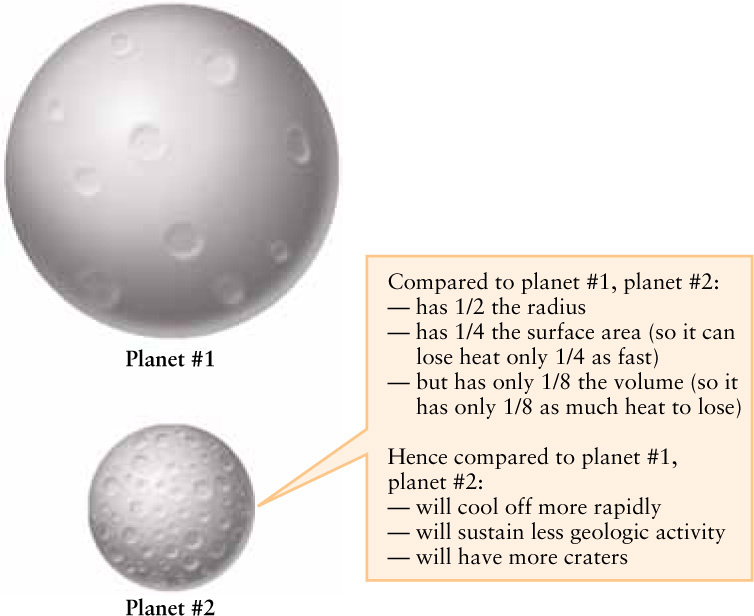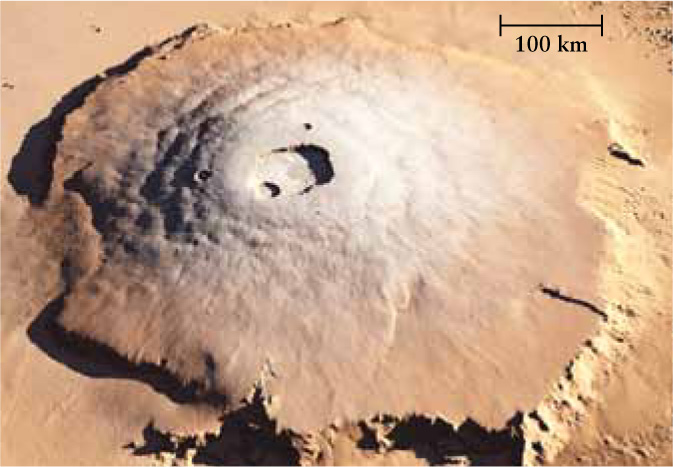7-6 Craters on planets and satellites are the result of impacts from interplanetary debris
Scientists study craters on a planet or satellite to learn the age and geologic history of the surface
One of the great challenges in studying planets and satellites is determining their internal structures. Are they solid or liquid inside? If there is liquid in the interiors, is the liquid calm or in agitated motion? Because planets are opaque, we cannot see directly into their interiors to answer these questions. But we can gather important clues about the interiors of terrestrial planets and satellites by studying the extent to which their surfaces are covered with craters (Figure 7-10). To see how information about the interiors is gathered, we first need to understand where craters come from.

Impact Craters These images, all taken from spacecraft, show impact craters on three different worlds. (a) The Moon’s surface has craters of all sizes. The large crater near the middle of this image is about 80 km (50 mi) in diameter, equal to the length of San Francisco Bay. (b) Manicouagan Reservoir in Quebec is the relic of a crater formed by an impact more than 200 million years ago. The crater was eroded over the ages by the advance and retreat of glaciers, leaving a ring lake 100 km (60 mi) across. (c) Lowell Crater in the southern highlands of Mars is 201 km (125 mi) across. Like the image of the Moon in part (a), there are craters on top of craters. Note the light-colored frost formed by condensation of carbon dioxide from the Martian atmosphere.
The Origin of Craters
The planets orbit the Sun in roughly circular orbits. But many asteroids and comets are in more elongated orbits. Such an elongated orbit can put these small objects on a collision course with a planet or satellite. If the object collides with a Jovian planet, it is swallowed up by the planet’s thick atmosphere. (Astronomers actually saw an event of this kind in 1994, when a comet crashed into Jupiter.) But if the object collides with the solid surface of a terrestrial planet or a satellite, the result is an impact crater (see Figure 7-10). Such impact craters, found throughout the solar system, offer stark evidence of these violent collisions.
The easiest way to view impact craters is to examine the Moon through a telescope or binoculars. Some 30,000 lunar craters are visible, with diameters ranging from 1 km to several hundred km. Close-up photographs from lunar orbit have revealed millions of craters too small to be seen from Earth (Figure 7-10a). These smaller craters are thought to have been caused by impacts of relatively small objects called meteoroids, which range in size from a few hundred meters across to the size of a pebble or smaller. Meteoroids are the result of collisions between asteroids, whose orbits sometimes cross. The chunks of rock that result from these collisions go into independent orbits around the Sun, which can lead them to collide with the Moon or another world.
When German astronomer Franz Gruithuisen proposed in 1824 that lunar craters were the result of impacts, a major sticking point was the observation that nearly all craters are circular. If craters were merely gouged out by high-speed rocks, a rock striking the Moon in any direction except straight downward would have created a noncircular crater. A century after Gruithuisen, it was realized that a meteoroid colliding with the Moon generates a shock wave in the lunar surface that spreads out from the point of impact. Such a shock wave produces a circular crater no matter what direction the meteoroid was moving. (In a similar way, the craters made by artillery shells are almost always circular.) Many of the larger lunar craters also have a central peak, which is characteristic of a high-speed impact (see Figure 7-10a). Craters made by other processes, such as volcanic action, would not have central peaks of this sort.
Comparing Cratering on Different Worlds
Not all planets and satellites show the same amount of cratering. The Moon is heavily cratered over its entire surface, with craters on top of craters, as shown in Figure 7-10a. On Earth, by contrast, craters are very rare. Geologists have identified fewer than 200 impact craters on our planet (Figure 7-10b). Our understanding is that both Earth and the Moon formed at nearly the same time and have been bombarded at comparable rates over their histories. Why, then, are craters so much rarer on Earth than on the Moon?

The answer is that Earth is a geologically active planet: Through plate tectonics—the motion of rocky plates over Earth’s surface—the continents slowly change their positions over eons, new material flows onto the surface from the interior (as occurs in a volcanic eruption), and old surface material is pushed back into the interior (as occurs off the coast of Chile, where the ocean bottom is slowly being pushed beneath the South American continent). These processes, coupled with erosion from wind and water, cause craters on Earth to be erased over time. The few craters found on Earth today must be relatively recent, since there has not yet been time to erase them.
The Moon, by contrast, is geologically inactive. There are no volcanoes and no motion of continents (and, indeed, no continents). Furthermore, the Moon has neither oceans nor an atmosphere, so there is no erosion as we know it on Earth. With none of the processes that tend to erase craters on Earth, the Moon’s surface remains pockmarked with the scars of billions of years of impacts.
In order for a planet to be geologically active, its interior must be at least partially molten. Even if the surface does not undergo plate tectonics—as in the case of Jupiter’s moon Io—a partially molten interior is required to generate volcanoes with molten lava. Therefore, we would expect geologically inactive (and hence heavily cratered) worlds like the Moon to have less molten material in their interiors than does Earth. Investigation of these inactive worlds bears this out. But why is the Moon’s interior less molten than Earth’s?
ANALOGY
To see one simple answer to this question, notice that a large turkey or roast taken from the oven will stay warm inside for hours, but a single meatball will cool off much more rapidly. The reason is that the meatball has more surface area relative to its volume, and so it can more easily lose heat to its surroundings. A planet or satellite also tends to cool down as it emits electromagnetic radiation into space (see Section 5-3); the smaller the planet or satellite, the greater its surface area relative to its volume, and the more readily it can radiate away heat (Figure 7-11). Both Earth and the Moon were probably completely molten when they first formed, but because the Moon (diameter 3476 km) is so much smaller than Earth (diameter 12,756 km), it has lost much of its internal heat and has a much more solid interior. There are two main sources for a planet’s heat, which we will discuss in Chapter 8—gravity and radioactivity—and both of these sources result in more heat for larger planets.
Cratering Measures Geologic Activity
By considering these differences between Earth and the Moon, we have uncovered a general rule for worlds with solid surfaces:
The smaller the terrestrial world, the less internal heat it is likely to have retained, and, thus, the less geologic activity it will display on its surface. The less geologically active the world, the older and hence more heavily cratered its surface.

A Martian Volcano Olympus Mons is the largest of the inactive volcanoes of Mars and the largest volcano in the solar system. The base of Olympus Mons measures 600 km (370 mi) in diameter, and the scarps (cliffs) that surround the base are 6 km (4 mi) high. The caldera, or volcanic crater, at the summit is approximately 70 km across, large enough to contain the state of Rhode Island.
This rule means that we can use the amount of cratering visible on a planet or satellite to estimate the age of its surface and how geologically active it is. As an example, Mercury has a heavily cratered surface, which means that the surface is very old. This geologically inactive surface is in agreement with Mercury being the smallest of the terrestrial planets (see Table 7-1). Due to its small size, it has lost the internal heat required to sustain geologic activity. On Venus, by comparison, there are only about a thousand craters larger than a few kilometers in diameter, many more than have been found on Earth but only a small fraction of the number on the Moon or Mercury. Venus is only slightly smaller than Earth, and it has enough internal heat to power the geologic activity required to erase most of its impact craters.
Mars is an unusual case, in that extensive cratering (Figure 7-10c) is found only in the higher terrain; the lowlands of Mars are remarkably smooth and free of craters. Thus, it follows that the Martian highlands are quite old, while the lowlands have a younger surface from which most craters have been erased. Considering the planet as a whole, the amount of cratering on Mars is intermediate between that on Mercury and Earth. This agrees with our general rule, because Mars is intermediate in size between Mercury and Earth. The interior of Mars was once hotter and more molten than it is now, so that geologic processes were able to erase some of the impact craters. A key piece of evidence that supports this picture is that Mars has a number of immense volcanoes (Figure 7-12). These volcanoes were active when Mars was young, but as this relatively small planet cooled down and its interior solidified, the supply of molten material to the volcanoes from the Martian interior was cut off. As a result, all of the volcanoes of Mars are now inactive.
As for all rules, there are limitations and exceptions to the rule relating a world’s size to its geologic activity. One limitation is that the four terrestrial planets all have slightly different compositions, which affects the types and extent of geologic activity that can take place on their surfaces. The different compositions also complicate the relationship between the number of craters and the age of the surface. An important exception to our rule is Jupiter’s satellite Io, which, despite its small size, is the most volcanic world in the solar system (see Section 7-2). Something must be supplying Io with energy to keep its interior hot; this energy comes from Jupiter, which exerts powerful tidal forces on Io as it moves in a relatively small orbit around its planet. These tidal forces cause Io to flex like a ball of clay being kneaded between your fingers, and this flexing heats up the satellite’s interior. But despite these limitations and exceptions, the relationships between a world’s size, internal heat, geologic activity, and amount of cratering are powerful tools for understanding the terrestrial planets and satellites.
CONCEPT CHECK 7-11
Io, which is a moon, is an exception to the rule that smaller worlds should have less geologic activity. Do you expect that some small planets might break this rule as well?
No. Io’s heat comes from tidal forces exerted by a very massive Jupiter. A planet, on the other hand, is not likely to experience strong interior-melting tidal forces from its smaller, orbiting moons.